List of Annual Events
January
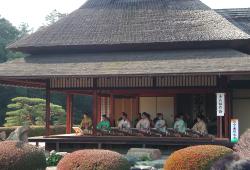
January 1 to 3
EARLY SPRING FESTIVAL
Free admission on January 1
Hatsuharu (“Early Spring”) is the ancient Japanese name for New Year’s Day. This event adds color to the celebrations in Korakuen. At En’yō-tei House you can enjoy events befitting of the New Year, such as a koto concert and the release of the splendid red-crowned cranes, birds that are considered auspicious symbols.
February
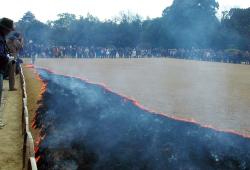
Early February
GRASS BURNING
13:00 to 15:00
It is a traditional Korakuen’s New Year event that began in 1965: the brown grass is set on fire and chars to black to get rid of the pests, just before the new buds and sprouts appear announcing the upcoming spring.

Late February
KOMO STRAW BELTS BONFIRE
10:00 to 10:30
The old komo straw wrappings, applied to the pine trees the previous autumn, are removed and burned to dispose of the pests that spent the winter inside them. The burning of the straw wrappings is said to signify the coming of spring to Korakuen.
March
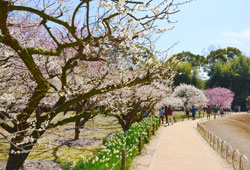
March 2
GARDEN OPENING COMMEMORATION DAY
Free admission
In 1884, Marquess Ikeda ceded Korakuen to Okayama Prefecture, which opened it to the general public on March 2nd. In 2000 that day was designated as the memorial day to commemorate the opening of the Korakuen, 300 years after the garden was built, and since then it became a free admission day.
April
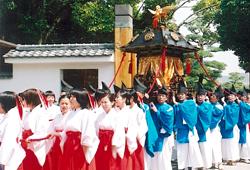
First Sunday of April
GOSHINKŌ SHINTŌ FESTIVAL
Goshinkō is a Shintō festival celebrated at Munetada Shrine in Okayama City. Its most famous event is a procession, about 1 km in length, composed of people wearing historical costumes who marches through the city and stops at Korakuen on the way.
Sponsored by: Munetada Shrine Committee, Okayama Chamber of Commerce.

Fourth Sunday of April
YŌSAI TEA CEREMONY
This solemn event began in 1933 to honor Yōsai (also known as Eisai), the Zen Buddhist priest and tea master from Okayama who introduced the tea culture in Japan from China.
It is a large event composed of a kencha (ceremonial tea offering), five formal tea ceremonies in different venues and different styles performed by the tea associations of Okayama, and a public nodate (open-air tea ceremony) open to beginners too.
Sponsored by: Yōsai Zenji Appreciation Committee, The Sanyo Shimbun.
May
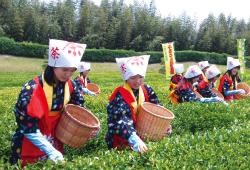
Third Sunday of May
TEA PICKING FESTIVAL
10:30, 11:30, 13:30
(each session lasts about 20 minutes)
An event taking place at Korakuen since 1956 and related to the historical Tea Plantation of the garden.
The Tea Picking Dance Preservation Society based in Kaita, Mimasaka City, one of the tea-growing regions of Okayama Prefecture, offers a performance of the tea-picking folk dance as well as a demonstration of tea handpicking, both of them performed by young maidens wearing traditional attires. After admiring the maidens carefully picking the first three leaves from the tea plants, the visitors can try picking tea by themselves in the plantation. Numerous stalls of local artisans allow visitors to taste the new tea or to pack their own hand-picked leaves.
June

Second Sunday of June
RICE PLANTING FESTIVAL
11:00, 13:00
(each session lasts about 1 hour)
A historical re-enactment began in 1962 and traditionally announcing the beginning of summer.
The Kōjiro Folk Song Preservation Society perform the rice planting folk dance, while the rice is planted by the members of the Rice Planting Preservation Society based in Tessei Town, Niimi City in Okayama Prefecture. The rice seedlings are handled by young ladies called saotome, who wear deep blue patterned kimonos and straw hats, and work on the upbeat tempo beaten by a group of male drummers and singers called sage.
July

First Sunday of July
LOTUS VIEWING FESTIVAL
4:00 to 8:00
This event is known in Japanese as Kanrensetsu (literally “A good occasion to see the lotus flowers”) and began in 1956.
For this very special occasion, the garden opens its gates before dawn to let visitors admire the blooming of the gorgeous, large and white Ittenshikai lotus and the sweet, smaller and pink Ōga lotus. During the event it is possible to listen to a koto concert at En’yō-tei House and, for a fee, to attend a chaseki (Japanese tea party) and eat a dim sum breakfast (traditional in Buddhist temples).
Tickets including garden admission, chaseki and dim sum breakfast are available in advance at the Okayama Korakuen Garden Main Gate Information Center as well as at the Tsujirien and Jōshōen tea shops in Okayama.
August

August 1 to 31
Night Opening and Illumination Event
SUMMER FANTASY GARDEN
Closing time extended to 21:30
Visit the garden marvelously illuminated by dreamy lights, enjoy the gourmet stands and take part in the many activities.
September, October

15th day of the 8th month of the old lunar calendar
HARVEST MOON VIEWING CEREMONY
Closing time extended to 21:30
The Harvest Moon Viewing Ceremony has been held since 1956 on the day when the Harvest Moon appears, known as the 15th day of the 8th month of the old lunar calendar and currently happening around mid-September according to the lunar cycle.
The garden closing time is extended from dusk until 21:30 to let the visitors gaze at the Moon rising over the mountain ridge without being obscured by buildings at all, although the garden sits at the center of a metropolitan area. The event offers the very rare opportunity to freely stroll on the lawns (which are usually off-limits), to enjoy a koto concert performed at En’yō-tei House and, for a fee, to participate in a chaseki (Japanese tea party).
Tickets including garden admission and chaseki are available in advance at the Okayama Korakuen Garden Main Gate Information Center as well as at the Tsujirien and Jōshōen tea shops in Okayama.
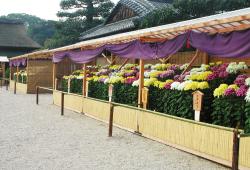
Late October to Mid-November
OKAYAMA PREFECTURE CHRYSANTHEMUM CONVENTION
Since 1958, this exhibition features a gorgeous display of about 300 pots of chrysanthemum flowers provided by the best growers from the whole prefecture. A wide variety of flowers in many hues, shapes, sizes and arrangements spread out their fragrant aroma and bring colors to the garden.
Sponsor: Okayama Prefectural Government, Okayama Prefecture Chrysanthemum Promotion Committee
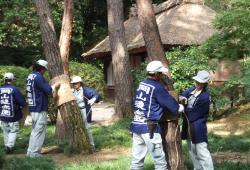
Late October
KOMO STRAW BELTS WRAPPING
9:30 to 15:00
Every year towards the end of October, all the about 280 pine trees in Korakuen are wrapped with protective rice straw coverings known as komo. These belts are used for a pest control method employed since ancient times, taking advantage of the behavior of the insects to come down from the branches and dig a nest to get through the cold season. Komos are placed around the trunk of each pine tree in the garden, so that rather than move to the ground the insects found there a warm place to spend winter. The next spring, before the first week of March (a period known in Japan as Keichitsu, “awakening of hibernating insects”), the straw wrappings are removed from the trunks and burned, killing the pests.
November

November 3, Culture Day
KORAKUNŌ
12:00 to 16:00
(starting time may vary depending on the program)
The best schools of Nō from all over Japan come to Korakuen to enact the masterpieces of Japanese theater. This event has been held every year since 1972, thirteen years after the post-war reconstruction of the Nō Theater Stage. It is greatly helping to spread the Nō theater classical art and to develop regional culture.
Sponsored by: Okayama Prefectural Government, Okayama Nō Committee.
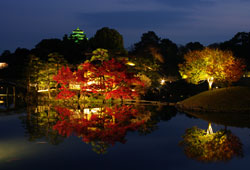
Mid-November to Late November
Night Opening and Illumination Event
AUTUMN FANTASY GARDEN
Garden closing time is extended to 20:30.
Visit the garden marvelously illuminated by dreamy lights, enjoy the gourmet stands and take part in the many activities.
N.B.: please pay attention that the events schedule and contents could be subject to unexpected changes.